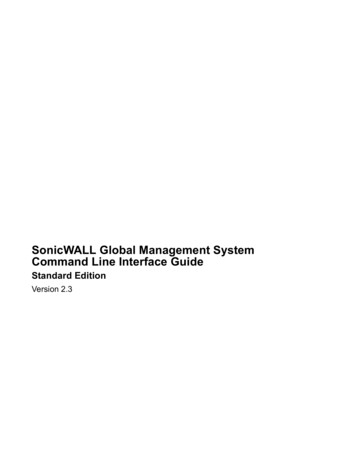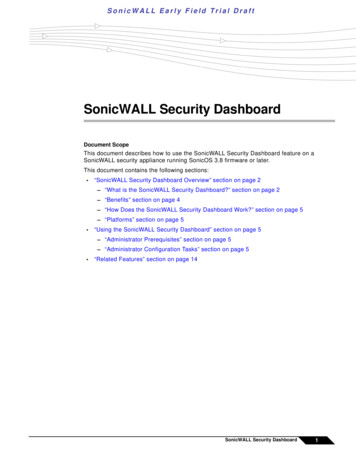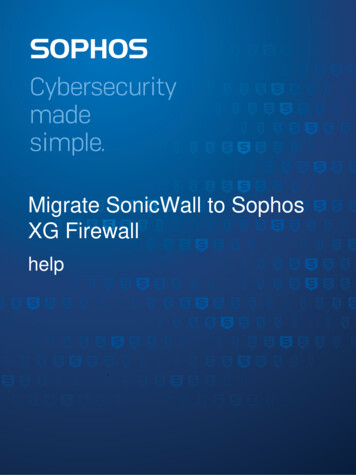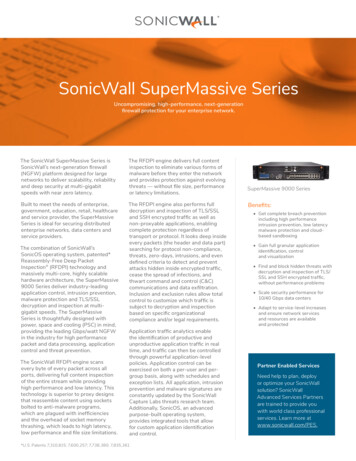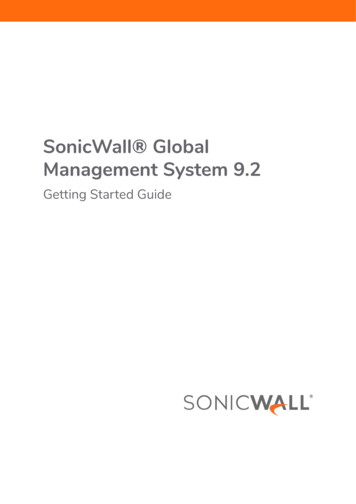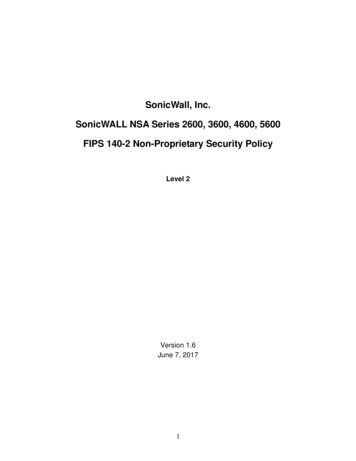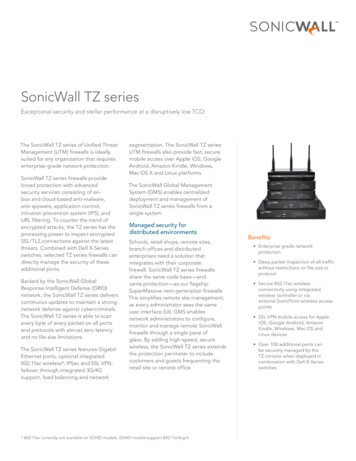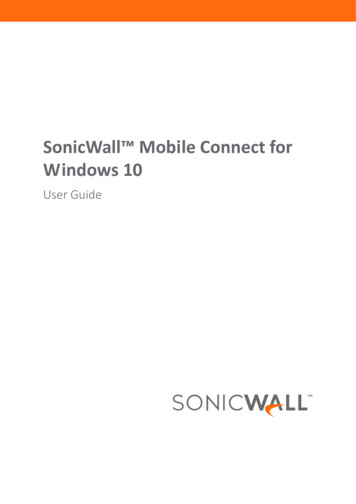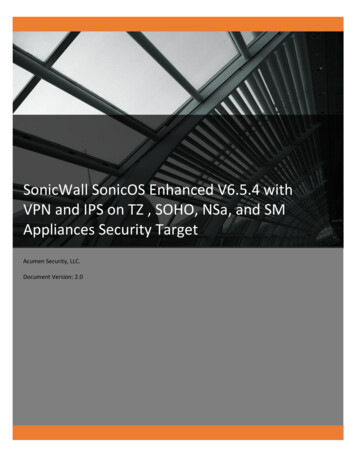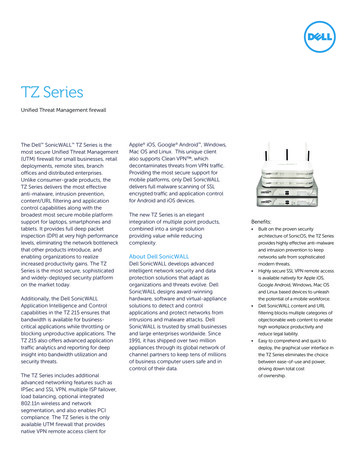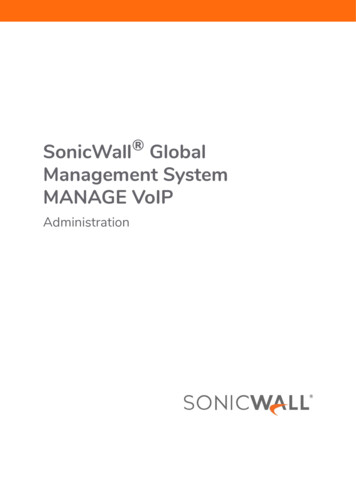
Transcription
SonicWall GlobalManagement SystemMANAGE VoIPAdministration
Contents1About VoIP . . . . . . . . . . . . . . . . . . . . . . . . . . . . . . . . . . . . . . . . . . . . . . . . . . . . . . . . . . . . . . . . . . . . . . . . . 3About VoIP . . . . . . . . . . . . . . . . . . . . . . . . . . . . . . . . . . . . . . . . . . . . . . . . . . . . . . . . . . . . . . . . . . . . . . . . . . .What is VoIP? . . . . . . . . . . . . . . . . . . . . . . . . . . . . . . . . . . . . . . . . . . . . . . . . . . . . . . . . . . . . . . . . . . . . .VoIP Security . . . . . . . . . . . . . . . . . . . . . . . . . . . . . . . . . . . . . . . . . . . . . . . . . . . . . . . . . . . . . . . . . . . . . .VoIP Protocols . . . . . . . . . . . . . . . . . . . . . . . . . . . . . . . . . . . . . . . . . . . . . . . . . . . . . . . . . . . . . . . . . . . .SonicWall’s VoIP Capabilities . . . . . . . . . . . . . . . . . . . . . . . . . . . . . . . . . . . . . . . . . . . . . . . . . . . . . . . .33346Configuring SonicWall VoIP Features . . . . . . . . . . . . . . . . . . . . . . . . . . . . . . . . . . . . . . . . . . . . . . . . . . . 14Configuration Tasks . . . . . . . . . . . . . . . . . . . . . . . . . . . . . . . . . . . . . . . . . . . . . . . . . . . . . . . . . . . . . . . . . . . 14Configuring VoIP . . . . . . . . . . . . . . . . . . . . . . . . . . . . . . . . . . . . . . . . . . . . . . . . . . . . . . . . . . . . . . . . . . 15Configuring Bandwidth on the WAN Interface . . . . . . . . . . . . . . . . . . . . . . . . . . . . . . . . . . . . . . . . . 19Configuring VoIP Access Rules . . . . . . . . . . . . . . . . . . . . . . . . . . . . . . . . . . . . . . . . . . . . . . . . . . . . . . 19Configuring VoIP Logging . . . . . . . . . . . . . . . . . . . . . . . . . . . . . . . . . . . . . . . . . . . . . . . . . . . . . . . . . . . 20SonicWall Support . . . . . . . . . . . . . . . . . . . . . . . . . . . . . . . . . . . . . . . . . . . . . . . . . . . . . . . . . . . . . . . . . . 21About This Document . . . . . . . . . . . . . . . . . . . . . . . . . . . . . . . . . . . . . . . . . . . . . . . . . . . . . . . . . . . . . . . . . 22Global Management System 9.2 AdministrationContents2
1About VoIPTopics: About VoIP What is VoIP? VoIP Security VoIP Protocols SonicWall’s VoIP CapabilitiesAbout VoIPTopics: What is VoIP? VoIP Security VoIP Protocols SonicWall’s VoIP CapabilitiesWhat is VoIP?Voice over IP (VoIP) is an umbrella term for a set of technologies that allow voice traffic to be carried overInternet Protocol (IP) networks. VoIP transfers the voice streams of audio calls into data packets as opposed totraditional, analog circuit-switched voice communications used by the public switched telephone network(PSTN).VoIP is the major driving force behind the convergence of networking and telecommunications by combiningvoice telephony and data into a single integrated IP network system. VoIP is all about saving cost for companiesthrough eliminating costly redundant infrastructures and telecommunication usage charges while alsodelivering enhanced management features and calling services features.VoIP SecurityCompanies implementing VoIP technologies in an effort to cut communication costs and extend corporate voiceservices to a distributed workforce face security risks associated with the convergence of voice and datanetworks. VoIP security and network integrity are an essential part of any VoIP deployment.The same security threats that plague data networks today are inherited by VoIP but the addition of VoIP as anapplication on the network makes those threats even more dangerous. By adding VoIP components to yournetwork, you are also adding new security requirements.Global Management System 9.2 AdministrationAbout VoIP3
VoIP encompasses a number of complex standards that leave the door open for bugs and vulnerabilities withinthe software implementation. The same types of bugs and vulnerabilities that hamper every operating systemand application available today also apply to VoIP equipment. Many of today's VoIP call servers and gatewaydevices are built on vulnerable Windows and Linux operating systems.Security Appliance Requirements for VoIPVoIP is more complicated than standard TCP/UDP-based applications. Because of the complexities of VoIPsignaling and protocols, as well as inconsistencies that are introduced when a Security Appliance modifiessource address and source port information with Network Address Translation (NAT), it is difficult for VoIP toeffectively traverse a standard Security Appliance. Here are a few of the reasons why. VoIP operates using two separate protocols - A signaling protocol (between the client and VoIP Server)and a media protocol (between the clients). Port/IP address pairs used by the media protocols(RTP/RTCP) for each session are negotiated dynamically by the signaling protocols. Firewalls need todynamically track and maintain this information, securely opening selected ports for the sessions andclosing them at the appropriate time. Multiple media ports are dynamically negotiated through the signaling session - negotiations of themedia ports are contained in the payload of the signaling protocols (IP address and port information).Firewalls need to perform deep packet inspection on each packet to acquire the information anddynamically maintain the sessions, consequently demanding extra Security Appliance processing. Source and destination IP addresses are embedded within the VoIP signaling packets - A SecurityAppliance supporting NAT translates IP addresses and ports at the IP header level for packets. Fullysymmetric NAT Security Appliances adjust their NAT bindings frequently, and might arbitrarily close thepinholes that allow inbound packets to pass into the network they protect, eliminating the serviceprovider's ability to send inbound calls to the customer. To effectively support VoIP it is necessary for aNAT Security Appliance to perform deep packet inspection and transformation of embedded IP addressesand port information as the packets traverse the Security Appliance. Firewalls need to process the signaling protocol suites consisting of different message formats used bydifferent VoIP systems - Just because two vendors use the same protocol suite does not necessarilymean they interoperate.To overcome many of the hurdles introduced by the complexities of VoIP and NAT, vendors are offering SessionBorder Controllers (SBCs). An SBC sits on the Internet side of a Security Appliance and attempts to control theborder of a VoIP network by terminating and re-originating all VoIP media and signaling traffic. In essence, SBCsact as a proxy for VoIP traffic for non-VoIP enabled Security Appliances. SonicWall Security Appliances are VoIPenabled Security Appliances that eliminate the need for an SBC on your network.NOTE: VoIP is supported on all SonicWall appliances that can run GMS, as long as the VoIP application isRFC-compliant.VoIP ProtocolsVoIP technologies are built on two primary protocols: H.323 and SIP. These protocols can be applied eitherglobally or per firewall rule.Topics: H.323 SIPGlobal Management System 9.2 AdministrationAbout VoIP4
H.323H.323 is a standard developed by the International Telecommunications Union (ITU). It is a comprehensive suiteof protocols for voice, video, and data communications between computers, terminals, network devices, andnetwork services. H.323 is designed to enable users to make point-to-point multimedia phone calls overconnectionless packet-switching networks such as private IP networks and the Internet. H.323 is widelysupported by manufacturers of video conferencing equipment, VoIP equipment and Internet telephonysoftware and devices.H.323 uses a combination of TCP and UDP for signaling and ASN.1 for message encoding. H.323v1 was releasedin 1996 and H.323v5 was released in 2003. As the older standard, H.323 was embraced by many early VoIPplayers.An H.323 network consists of four different types of entities: Terminals - Client end points for multimedia communications. An example would be an H.323 enabledInternet phone or PC. Gatekeepers - Performs services for call setup and tear down, and registering H.323 terminals forcommunications. Includes: Address translation. Registration, admission control, and status (RAS). Internet Locator Service (ILS) also falls into this category (although it is not part of H.323). ILS usesLDAP (Lightweight Directory Access Protocol) rather than H.323 messages. Multipoint control units (MCUs) - Conference control and data distribution for multipointcommunications between terminals. Gateways - Interoperation between H.323 networks and other communications services, such as thecircuit-switched Packet Switched Telephone Network (PSTN).SIPThe Session Initiation Protocol (SIP) standard was developed by the Internet Engineering Task Force (IETF). RFC2543 was released in March 1999. RFC 3261 was released in June 2002. SIP is a signaling protocol for initiating,managing and terminating sessions. SIP supports ‘presence’ and mobility and can run over User DatagramProtocol (UDP) and Transmission Control Protocol (TCP).Using SIP, a VoIP client can initiate and terminate call sessions, invite members into a conferencing session, andperform other telephony tasks. SIP also enables Private Branch Exchanges (PBXs), VoIP gateways, and othercommunications devices to communicate in standardized collaboration. SIP was also designed to avoid theheavy overhead of H.323.A SIP network is composed of the following logical entities: User Agent (UA) - Initiates, receives and terminates calls. Proxy Server - Acts on behalf of UA in forwarding or responding to requests. A Proxy Server can forkrequests to multiple servers. A back-to-back user agent (B2BUA) is a type of Proxy Server that treats eachleg of a call passing through it as two distinct SIP call sessions: one between it and the calling phone andthe other between it and the called phone. Other Proxy Servers treat all legs of the same call as a singleSIP call session. Redirect Server - Responds to request but does not forward requests. Registration Server - Handles UA authentication and registration.Global Management System 9.2 AdministrationAbout VoIP5
SonicWall’s VoIP CapabilitiesIMPORTANT: If Wireless-Controller-Only mode has been selected for Wireless LAN Controller, VoIP isdisabled.Topics: VoIP Security VoIP Network VoIP Network Interoperability Supported Interfaces Supported VoIP Protocols BWM and QoS How GMS Handles VoIP CallsVoIP Security Traffic legitimacy - Stateful inspection of every VoIP signaling and media packet traversing the SecurityAppliance ensures all traffic is legitimate. Packets that exploit implementation flaws, causing effects suchas buffer overflows in the target device, are the weapons of choice for many attackers. SonicWallSecurity Appliances detect and discard malformed and invalid packets before they reach their intendedtarget. Application-layer protection for VoIP protocols - Full protection from application-level VoIP exploitsthrough SonicWall Intrusion Prevention Service (IPS). IPS integrates a configurable, high performancescanning engine with a dynamically updated and provisioned database of attack and vulnerabilitysignatures to protect networks against sophisticated Trojans and polymorphic threats. SonicWall extendsits IPS signature database with a family of VoIP-specific signatures designed to prevent malicious trafficfrom reaching protected VoIP phones and servers. DoS and DDoS attack protection - Prevention of DoS and DDoS attacks, such as the SYN Flood, Ping ofDeath, and LAND (IP) attack, which are designed to disable a network or service. Validating packet sequence for VoIP signaling packets using TCP to disallow out of sequence andretransmitted packets beyond window. Using randomized TCP sequence numbers (generated by a cryptographic random numbergenerator during connection setup) and validating the flow of data within each TCP session toprevent replay and data insertion attacks. Ensures that attackers cannot overwhelm a server by attempting to open many TCP/IPconnections (which are never fully established-usually because of a spoofed source address) byusing SYN Flood protection. Stateful monitoring - Stateful monitoring ensures that packets, even though appearing valid inthemselves, are appropriate for the current state of their associated VoIP connection. Encrypted VoIP device support - SonicWall supports VoIP devices capable of using encryption to protectthe media exchange within a VoIP conversation or secure VoIP devices that do not support encryptedmedia using IPsec VPNs to protect VoIP calls. Application-layer protection - SonicWall delivers full protection from application-level VoIP exploitsthrough SonicWall Intrusion Prevention Service (IPS). SonicWall IPS is built on a configurable, highperformance Deep Packet Inspection engine that provides extended protection of key network servicesincluding VoIP, Windows services, and DNS. The extensible signature language used in SonicWall’s DeepPacket Inspection engine also provides proactive defense against newly discovered application andGlobal Management System 9.2 AdministrationAbout VoIP6
protocol vulnerabilities. Signature granularity allows SonicWall IPS to detect and prevent attacks basedon a global, attack group, or per-signature basis to provide maximum flexibility and control falsepositives.VoIP Network VoIP over Wireless LAN (WLAN) - SonicWall extends complete VoIP security to attached wirelessnetworks with its Distributed Wireless Solution. All of the security features provided to VoIP devicesattached to a wired network behind a SonicWall are also provided to VoIP devices using a wirelessnetwork.NOTE: SonicWall’s Secure Wireless Solution includes the network enablers to extend secure VoIPcommunications over wireless networks. Refer to the SonicWall Secure Wireless NetworkIntegrated Solutions Guide available on the SonicWall Web site http://www.SonicWall.com forcomplete information. Bandwidth Management (BWM) and Quality-of-Service (QoS) - Bandwidth management (both ingressand egress) can be used to ensure that bandwidth remains available for time-sensitive VoIP traffic. BWMis integrated into SonicWall Quality of Service (QoS) features to provide predictability that is vital forcertain types of applications. WAN redundancy and load balancing - WAN redundancy and load balancing allows for an interface toact as a secondary WAN port. This secondary WAN port can be used in a simple active/passive setup,where traffic is only routed through it if the primary WAN port is down or unavailable. Load balancingcan be performed by splitting the routing of traffic based on destination. High availability - High availability is provided by GMS high availability, which ensures reliable,continuous connectivity in the event of a system failure.VoIP Network Interoperability Plug-and-protect support for VoIP devices - With GMS, VoIP device adds, changes, and removals arehandled automatically, ensuring that no VoIP device is left unprotected. Using advanced monitoring andtracking technology, a VoIP device is automatically protected as soon as it is plugged into the networkbehind a Security Appliance. Full syntax validation of all VoIP signaling packets - Received signaling packets are fully parsed withinGMS to ensure they comply with the syntax defined within their associated standard. By performingsyntax validation, the Security Appliance can ensure that malformed packets are not permitted to passthrough and adversely affect their intended target. Support for dynamic setup and tracking of media streams - GMS tracks each VoIP call from the firstsignaling packet requesting a call setup, to the point where the call ends. Only based on the successfulcall progress are additional ports opened (for additional signaling and media exchange) between thecalling and called party.Media ports that are negotiated as part of the call setup are dynamically assigned by the SecurityAppliance. Subsequent calls, even between the same parties, uses different ports, thwarting an attackerwho might be monitoring specific ports. Required media ports are only opened when the call is fullyconnected, and are shut down upon call termination. Traffic that tries to use the ports outside of the callis dropped, providing added protection to the VoIP devices behind the Security Appliance. Validation of headers for all media packets - GMS examines and monitors the headers within mediapackets to allow detection and discarding of out-of-sequence and retransmitted packets (beyondwindow). Also, by ensuring that a valid header exists, invalid media packets are detected and discarded.By tracking the media streams as well as the signaling, SonicWall provides protection for the entire VoIPsession.Global Management System 9.2 AdministrationAbout VoIP7
Configurable inactivity timeouts for signaling and media - In order to ensure that dropped VoIPconnections do not stay open indefinitely, GMS monitors the usage of signaling and media streamsassociated with a VoIP session. Streams that are idle for more than the configured timeout are shut downto prevent potential security holes. GMS allows the administrator to control incoming calls - By requiring that all incoming calls areauthorized and authenticated by the H.323 Gatekeeper or SIP Proxy, GMS can block unauthorized andspam calls. This allows the administrator to be sure that the VoIP network is being used only for thosecalls authorized by the company. Comprehensive monitoring and reporting - For all supported VoIP protocols, GMS offers extensivemonitoring and troubleshooting tools: Dynamic live reporting of active VoIP calls, indicating the caller and called parties, and bandwidthused. Audit logs of all VoIP calls, indicating caller and called parties, call duration, and total bandwidthused. Logging of abnormal packets seen (such as a bad response) with details of the partiesinvolved and condition seen. Detailed syslog reports and ViewPoint reports for VoIP signaling and media streams. SonicWallViewPoint is a Web-based graphical reporting tool that provides detailed and comprehensivereports of your security and network activities based on syslog data streams received from theSecurity Appliance. Reports can be generated about virtually any aspect of Security Applianceactivity, including individual user or group usage patterns and events on specific SecurityAppliances or groups of Security Appliances, types and times of attacks, resource consumptionand constraints.Supported InterfacesVoIP devices are supported on the following GMS zones: Trusted zones (LAN, VPN) Untrusted zones (WAN) Public zones (DMZ) Wireless zones (WLAN)Supported VoIP ProtocolsTopics: H.323 SIP SonicWall VoIP Vendor Interoperability CODECs VoIP Protocols on which GMS Does Not Perform Deep Packet InspectionH.323GMS provides the following support for H.323: VoIP devices running all versions of H.323 (currently 1 through to 5) are supported Microsoft's LDAP-based Internet Locator Service (ILS)Global Management System 9.2 AdministrationAbout VoIP8
Discovery of the Gatekeeper by LAN H.323 terminals using multicast Stateful monitoring and processing of Gatekeeper registration, admission, and status (RAS) messages Support for H.323 terminals that use encryption for the media streams DHCP Option 150. The DHCP Server can be configured to return the address of a VoIP specific TFTP serverto DHCP clients In addition to H.323 support, GMS supports VoIP devices using the following additional ITU standards: T.120 for application sharing, electronic white-boarding, file exchange, and chat H.239 to allow multiple channels for delivering audio, video and data H.281 for Far End Camera Control (FECC)SIPGMS provides the following support for SIP: Base SIP standard (both RFC 2543 and RFC 3261) SIP INFO method (RFC 2976) Reliability of provisional responses in SIP (RFC 3262) SIP specific event notification (RFC 3265) SIP UPDATE method (RFC 3311) DHCP option for SIP servers (RFC 3361) SIP extension for instant messaging (RFC 3428) SIP REFER method (RFC 3515) Extension to SIP for symmetric response routing (RFC 3581)SonicWall VoIP Vendor InteroperabilityPartial List of Devices with which SonicWall VoIP Interoperates lists many devices from leading manufacturerswith which SonicWall VoIP interoperates.Global Management System 9.2 AdministrationAbout VoIP9
Partial List of Devices with which SonicWall VoIP InteroperatesH.323SIPSoft-Phones:AvayaMicrosoft NetMeetingOpenPhonePolyComSJLabs SJ mSonyGatekeepers:CiscoOpenH323 GatekeeperGateway:CiscoSoft-Phones:Apple iChatAvayaMicrosoft MSN MessengerNortel Multimedia PC ClientPingTel Instant XpressaPolyComSiemens SCS Client SJLabsSJPhoneXTen X-LiteUbiquity SIP User AgentTelephones/ATAs:AvayaCiscoGrandstream BudgetOneMitelPacket8 ATAPingTel Xpressa PolyComPolyComPulver Innovations WiSIPSoundPointSIP Proxies/Services:Cisco SIP Proxy ServerBrekeke Software OnDo SIP ProxyPacket8Siemens SCS SIP ProxyVonageCODECs GMS supports media streams from any CODEC - Media streams carry audio and video signals that havebeen processed by a hardware/software CODEC (COder/DECoder) within the VoIP device. CODECs usecoding and compression techniques to reduce the amount of data required to represent audio/videosignals. Some examples of CODECs are: H.264, H.263, and H.261 for video MPEG4, G.711, G.722, G.723, G.728, G.729 for audioVoIP Protocols on which GMS Does Not Perform Deep PacketInspectionSonicWall network Security Appliances do not currently support deep packet inspection for the followingprotocols; therefore, these protocols should only be used in non-NAT environments. Proprietary extensions to H.323 or SIP MGCP Megaco/H.248 Cisco Skinny Client Control Protocol (SCCP) IP-QSIG Proprietary protocols (Mitel’s MiNET, 3Com NBX, and so on.)Global Management System 9.2 AdministrationAbout VoIP10
BWM and QoSOne of the greatest challenges for VoIP is ensuring high speech quality over an IP network. IP was designedprimarily for asynchronous data traffic, which can tolerate delay. VoIP, however, is very sensitive to delay andpacket loss. Managing access and prioritizing traffic are important requirements for ensuring high-quality,real-time VoIP communications.SonicWall’s integrated Bandwidth Management (BWM) and Quality of Service (QoS) features provide the toolsfor managing the reliability and quality of your VoIP communications.Quality of ServiceQoS encompasses a number of methods intended to provide predictable network behavior and performance.Network predictability is vital to VoIP and other mission critical applications. No amount of bandwidth canprovide this sort of predictability, because any amount of bandwidth is ultimately used to its capacity at somepoint in a network. Only QoS, when configured and implemented correctly, can properly manage traffic, andguarantee the desired levels of network service.GMS includes QoS features that adds the ability to recognize, map, modify and generate the industry-standard802.1p and Differentiated Services Code Points (DSCP) Class of Service (CoS) designators.How GMS Handles VoIP CallsGMS provides an efficient and secure solution for all VoIP call scenarios. The following are examples of how GMShandles VoIP call flows: Incoming Calls Local CallsIncoming CallsIncoming Call Sequence of Events shows the sequence of events that occurs during an incoming call.Global Management System 9.2 AdministrationAbout VoIP11
Incoming Call Sequence of EventsKEYSignalingMediaPhoneAVoIP Server325InternetNSa 5650061PhoneB4The following describes the sequence of events shown in Incoming Call Sequence of Events:1 Phone B registers with VoIP server - The Security Appliance builds a database of the accessible IPphones behind it by monitoring the outgoing VoIP registration requests. GMS translates between phoneB’s private IP address and the Security Appliance’s public IP address used in registration messages. TheVoIP server is unaware that phone B is behind a Security Appliance and has a private IP address—itassociates phone B with the Security Appliance’s public IP address.2 Phone A initiates a call to phone B - Phone A initiates a call to phone B using a phone number or alias.When sending this information to the VoIP server, it also provides details about the media types andformats it can support as well as the corresponding IP addresses and ports.3 VoIP Server validates the call request and sends the request to phone B - The VoIP server sends the callrequest to the Security Appliance’s public IP address. When it reaches the Security Appliance, GMSvalidates the source and content of the request. The Security Appliance then determines phone B’sprivate IP address.4 Phone B rings and is answered - When phone B is answered, it returns information to the VoIP server forthe media types and formats it supports as well as the corresponding IP addresses and ports. GMStranslates this private IP information to use the Security Appliance’s public IP address for messages to theVoIP server.5 VoIP server returns phone B media IP information to phone A - Phone A now has enough information tobegin exchanging media with Phone B. Phone A does not know that Phone B is behind a SecurityAppliance, as it was given the public address of the Security Appliance by the VoIP Server.6 Phone A and phone B exchange audio/video/data through the VoIP server - Using the internaldatabase, GMS ensures that media comes from only Phone A and is only using the specific mediastreams permitted by Phone B.Local CallsLocal VoIP Call Sequence of Events shows the sequence of events that occurs during a local VoIP call.Global Management System 9.2 AdministrationAbout VoIP12
Local VoIP Call Sequence of EventsKEYSignalingMediaVoIP Server62InternetNSa 5650143PhoneAPhone7B5The following describes the sequence of events shown in Local VoIP Call Sequence of Events:1 Phones A and B register with VoIP server - The Security Appliance builds a database of the accessible IPphones behind it by monitoring the outgoing VoIP registration requests. GMS translates between thephones’ private IP addresses and the Security Appliance’s public IP address. The VoIP server is unawarethat the phones are behind a Security Appliance. It associates the same IP address for both phones, butdifferent port numbers.2 Phone A initiates a call to phone B by sending a request to the VoIP server - Even though they arebehind the same Security Appliance, phone A does not know Phone B’s IP address. Phone A initiates acall to phone B using a phone number or alias.3 VoIP Server validates the call request and sends the request to phone B - The VoIP server sends the callrequest to the Security Appliance’s public IP address. The Security Appliance then determines phone B’sprivate IP address.4 Phone B rings and is answered - When phone B is answered, the Security Appliance translates its privateIP information to use the Security Appliance’s public IP address for messages to the VoIP server.5 VoIP Server returns phone B media IP information to phone A - Both the called and calling partyinformation within the messages are translated by GMS back to the private addresses and ports forphone A and phone B.6 Phone A and phone B directly exchange audio/video/data - The Security Appliance routes trafficdirectly between the two phones over the LAN. Directly connecting the two phones reduces thebandwidth requirements for transmitting data to the VoIP server and eliminates the need for theSecurity Appliance to perform address translation.Global Management System 9.2 AdministrationAbout VoIP13
2Configuring SonicWall VoIP FeaturesTopics: Configuration Tasks Configuring VoIP Configuring Bandwidth on the WAN Interface Configuring VoIP Access Rules Configuring VoIP LoggingConfiguration TasksConfiguring the SonicWall Security Appliance for VoIP deployments builds on your basic network configurationin the SonicWall Management Interface. This section assumes the Security Appliance is configured for yournetwork environment.NOTE: For general information about VoIP, see About VoIP.Topics: Configuring VoIP Configuring Bandwidth on the WAN Interface Configuring VoIP Access Rules Configuring VoIP LoggingGlobal Management System 9.2 AdministrationConfiguring SonicWall VoIP Features14
Configuring VoIPIMPORTANT: If Wireless-Controller-Only mode has been selected as the Wireless LAN Controller, anyattempt to enable SIP or H.323 options displays an error message in the lower right corner of the browserwindow.Clicking the View List link displays an error log.Configure VoIP with settings located at VoIP Settings. The page is divided into three sections: Configuring General Settings Configuring Session Initiation Protocol (SIP) Settings Configuring the H.323 SettingsTopics: Configuring General Settings Configuring Session Initiation Protocol (SIP) Settings Configuring the H.323 SettingsGlobal Management System 9.2 AdministrationConfiguring SonicWall VoIP Features15
Configuring General SettingsThere is one option under General Settings: Enable Consistent NAT.Consistent NAT enhances standard NAT policy to provide greater compatibility with peer-to-peer applicationsthat require a consistent IP address to connect to, such as VoIP. Consistent NAT uses an MD5 hashing method toconsistently assign the same mapped public IP address and UDP Port pair to each internal private IP address andport pair.For example, NAT could translate the private (LAN) IP address and port pairs, 192.116.168.10/50650 and192.116.168.20/50655 into public (WAN) IP/port pairs, as shown in IP Address and Port Pairs:IP Address and Port PairsPrivate IP/PortTranslated Public IP/Port192.1
SonicWall's VoIP Capabilities What is VoIP? Voice over IP (VoIP) is an umbrella term for a set of technologies that allow voice traffic to be carried over Internet Protocol (IP) networks. VoIP transfers the voice streams of audio calls into data packets as opposed to
